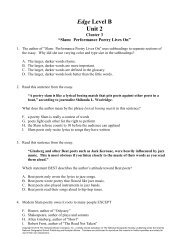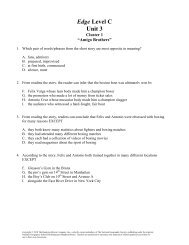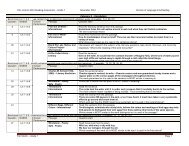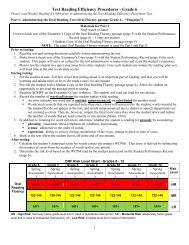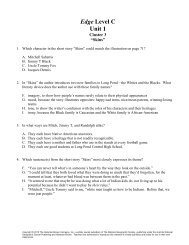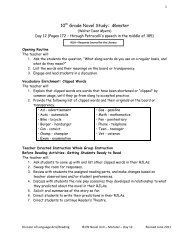Touching Spirit Bear - Division of Language Arts/Reading
Touching Spirit Bear - Division of Language Arts/Reading
Touching Spirit Bear - Division of Language Arts/Reading
- No tags were found...
You also want an ePaper? Increase the reach of your titles
YUMPU automatically turns print PDFs into web optimized ePapers that Google loves.
4In your regular sessions, your dance therapist will watch you dance, encourage you to express yourfeelings through movement, and, at times, imitate your movements (this is called "empathic mirroring")to establish rapport and make you feel accepted. The therapist may also try to help you connect yourthoughts, feelings, and memories to your movements.If you are part <strong>of</strong> a dance therapy group, the dance therapist will typically assess how the group workstogether--how you all interact and share emotional expression through movement--and intervene ordirect the action accordingly. For example, the therapist might introduce the idea <strong>of</strong> leading andfollowing to help draw a member <strong>of</strong> the group out <strong>of</strong> isolation or self-preoccupation. The dancetherapist might also employ equipment such as beanbags, balls, and stretch cloths to explore a theme,such as trust.The number <strong>of</strong> sessions, both for individual and group work, will vary. You might have to commit to atleast six months <strong>of</strong> treatment, depending on your ailment. The sessions are usually weekly, althoughthis can vary as well.Health BenefitsDance therapy has a broad range <strong>of</strong> health benefits. It has been demonstrated to be clinicallyeffective at improving body image, self-esteem, attentiveness, and communication skills. It can alsoreduce stress, fears and anxieties, as well as lessen feelings <strong>of</strong> isolation, body tension, chronic pain,and depression. In addition it can enhance the functioning <strong>of</strong> the body's circulatory and respiratorysystems.Dance therapy has also been shown to benefit adolescent and adult psychiatric patients, the learningdisabled, the visually and hearing impaired, the mentally handicapped, and the elderly (especiallythose in nursing homes).Proponents <strong>of</strong> dance therapy claim that it has also been used successfully to help people deal withbrain injury, AIDS, arthritis, amputation, stroke, cancer, and a number <strong>of</strong> other physical ailments.How To Choose a PractitionerDance therapists work independently or as part <strong>of</strong> a treatment team, which might include an M.D.,psychiatrist, psychologist, and/or other health-care provider. Whichever you prefer, your primary-carephysician might be able to provide a referral. In addition, the American Dance Therapy Association(ADTA) in Columbia, Maryland, maintains a registry <strong>of</strong> dance therapists who meet specific educationaland clinical practice standards. These include:Dance Therapy Registered (DTR). This designation is granted by the ADTA to entry-level dancetherapists who have a master's degree and have completed 700 hours <strong>of</strong> supervised clinical internship.DTR therapists are qualified for employment as dance therapists, but cannot work in private practice.• Academy <strong>of</strong> Dance Therapists Registered (ADTR). This advanced designation is granted bythe ADTA to DTRs who have completed 3,640 hours <strong>of</strong> supervised clinical work in an agency,institution, or special school, and have met various other requirements. ADTR therapists are qualified toengage in private practice.CautionsIf you have a physical or psychological ailment, consult your primary-care physician first. Yourphysician can refer you to a dance therapist or supervise your care as part <strong>of</strong> a treatment team thatincludes a dance therapist.It is important to find a dance therapist with whom you feel comfortable, since the dance therapyexperience involves spontaneity, trust, and the expression <strong>of</strong> sometimes difficult emotions.<strong>Division</strong> <strong>of</strong> <strong>Language</strong> <strong>Arts</strong>/<strong>Reading</strong> IR-EN Novel Unit – <strong>Spirit</strong> <strong>Bear</strong> – Day 15 Revised June 2011






